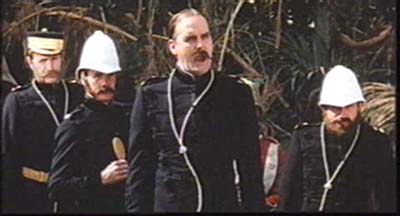The US Plan to defeat Great Britain, based on their assessment of the likely British plan to blockade the Atlantic and invade through New England to threaten the vital industrial heartland of the US (for more detail see
here).
Having assessed the likely British plan, US planners broadly concluded that:
- Naval situation in the Atlantic would at best be a standoff with neither side having no significant advantage, OR the British would sabotage the Panama Canal and gain a decisive advantage
- British efforts to lodge an invasion force would likely be staged using Canada as a forward operating base
- British Cruiser and submarine forces operating out of Canada and the Carribean would be sufficient to blockade the majority of merchant traffic, and
- British threats to the North East of the US would likely be effective before the American industrial and manpower superiority could be mobilised.
 |
| Allied convoy assembles in Halifax: Exactly what the US planners wanted to prevent |
In consideration of these factors, the US planner concluded that the answer to defeat Great Britain was to immediately go on the offensive and remove the British ability to utilise Canada and other forward operating bases, by seizing
“Red bases in the western North Atlantic, the West Indies, and the Caribbean.” The strategic priority was Halifax, Nova Scotia and its all important naval base which would be critical in supporting a forward deployed Royal Navy operating on the East Coast of the US. The US estimated it had a maximum of 14 days before the combined RN Home and Mediterranean Fleets would be operating on their doorstep. Use of this time would be critical.
The US Army had only limited initial resources but those available would strike north rapidly. Within 3 days of mobilisation, a Corps of 3 Divisions (some 25,000 troops) would muster at Boston. Depending on the situation, they could move north through Maine using the rail network to enhance their mobility, or proceed north under fleet escort to conduct an amphibious attack on Halifax. In considering the lessons of WW1, US submarine warfare would also be waged to interdict Canada from British shipping and deny the buildup of the forces required to undertake an invasion of the US and deploy accordingly.
 |
| The best defence... |
This track would also be supported by spoiling attacks along the eastern boarder. As troops became available, an advance would be made from upstate New York against Montreal and Quebec while another force would advance to take the hydro-electric plants on the Niagara River. Other moves would be made to safeguard the Detroit industrial region and capture other key infrastructure such as the Sault St marine canal and its locks. The occupation of Canadian territory was a priority, weather and logistic wallowing. Realistically, in these early stage there would be little that Canada could do without British reinforcement, though aggressive aerial attacks were expected with little that could be done to prevent them.
Back at Sea, the short period before the Royal Navy appearing in strength was critical. The US Atlantic fleet (4 Battleships plus cruiser support) would be used to strike British possessions. Initial targets were Jamaica, the Bahamas and Bermuda, to be followed up if possible with attacks on Trinidad, St Lucia and British possessions in the West Indies. These would reduce the use of these bases to interdict merchant traffic and help safeguard the Panama Canal. On the great lakes and in the pacific Canadian ports would be blockaded.
With the British ability to invade the East Coast significantly degraded, the US Army would focus on dislocating the Canadian Eats and West coasts to prevent a buildup of Indian or ANZAC troops from the Pacific coast. Capture of the Winnipeg rail centre, a crucial rail node, was key in this, followed by the occupation of Vancouver and British Columbia.
Overall, the US plan was to strike quickly to remove Canada as a staging point, prevent a British buildup and allow US mobilisation efforts to come to fruition. As unlikely as the situation was deemed, it was deemed to be a valid strategy.
Should Japan enter the War on the British side, a join War Plan Red-Orange would be activated (War Plan Orange being the contingency plan for war against Japan). British Naval strength was seen to be the biggest threat and the intent was to prosecute a "Red First" policy, analogously prescient to the 'Europe First' policy of WW2.
One point to consider - War Plan Red was developed in 1927 after the Geneva Naval Conference of that year, and was approved in 1930. Transplant this scenario to a VSF setting and a few different aspects come into play. The demilitarisation of the US-Canadian boarder, key to the US twentieth century plan, started in the late 1870s. Residual infrastructure could still be present and even be reactivated in a period of tension. Use of such facilities for aeronef raids into the US might degrade or delay the initial thrust into Halifax. Alternatively, an RN aquanef blockade could be established off the East Coast prior to hostilities, nullifying the initial US freedom of acton. Lots of possibilities.
Alternatively, if it appeals to you as is then there is a board game from
Avalanche Press you may wish to investigate (thanks Michael P, for the information).

 Let us be honest, it’s damned thirsty work for those smashing chaps of the Earth’s Armed Forces. Spending your days up to your danglies in mud and razor wire while bringing a bit of civilizing influence to those ugly Venusian brutes can leave a chap parched.
Let us be honest, it’s damned thirsty work for those smashing chaps of the Earth’s Armed Forces. Spending your days up to your danglies in mud and razor wire while bringing a bit of civilizing influence to those ugly Venusian brutes can leave a chap parched.



.jpg)



